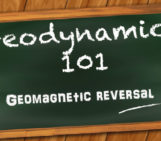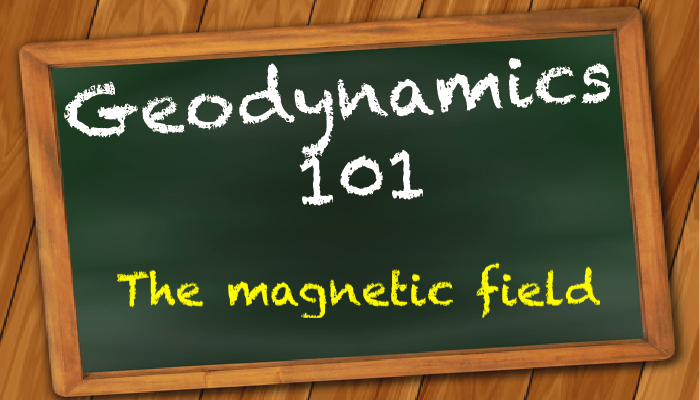
The Earth’s magnetic field plays a prominent role in our everyday life. From birds and bees to many modern-day technologies rely on the magnetic field, and yet, our understanding on its long- and short-term behavior is far from complete. In this week’s post, Annique van der Boon shows how geology and paleomagnetic studies can help us in understanding the long-term activity of Earth’s magnetic field.
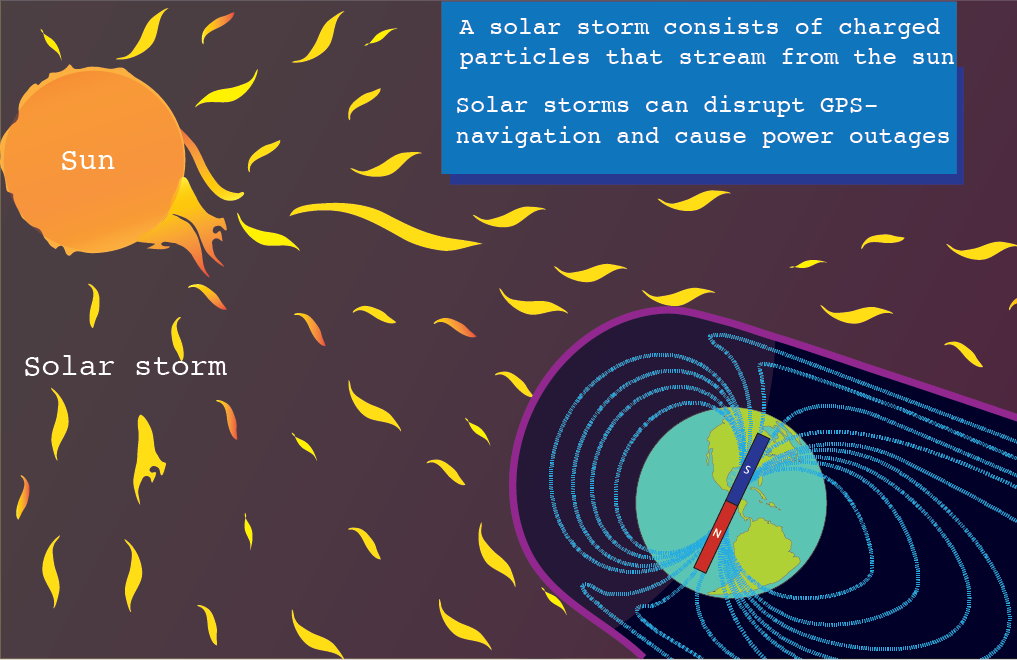 Earth’s magnetic field protects us from solar storms. The stronger the magnetic field is, the better the protection.
Earth’s magnetic field protects us from solar storms. The stronger the magnetic field is, the better the protection.
While you might not ever notice it’s here, Earth’s magnetic field plays an important role in our daily lives. It protects us from solar storms that consist of charged particles, which consist of charged particles and can be harmful for modern technology, and our phones use computer models of the magnetic field for navigation. Earth’s magnetic field also protects our atmosphere. In fact, we think that the atmosphere on Mars was blown away by the solar wind after Mars’ magnetic field shut down, around 3.7 billion years ago. The interaction between Earth’s magnetic field and solar storms also creates a beautiful phenomenon that many will know: the Northern lights. Despite the importance of Earth’s magnetic field in our lives, we know surprisingly little about why the magnetic field behaves the way it does. To understand this, we need to study how Earth’s magnetic field behaved over very long time periods, of hundreds of millions of years.
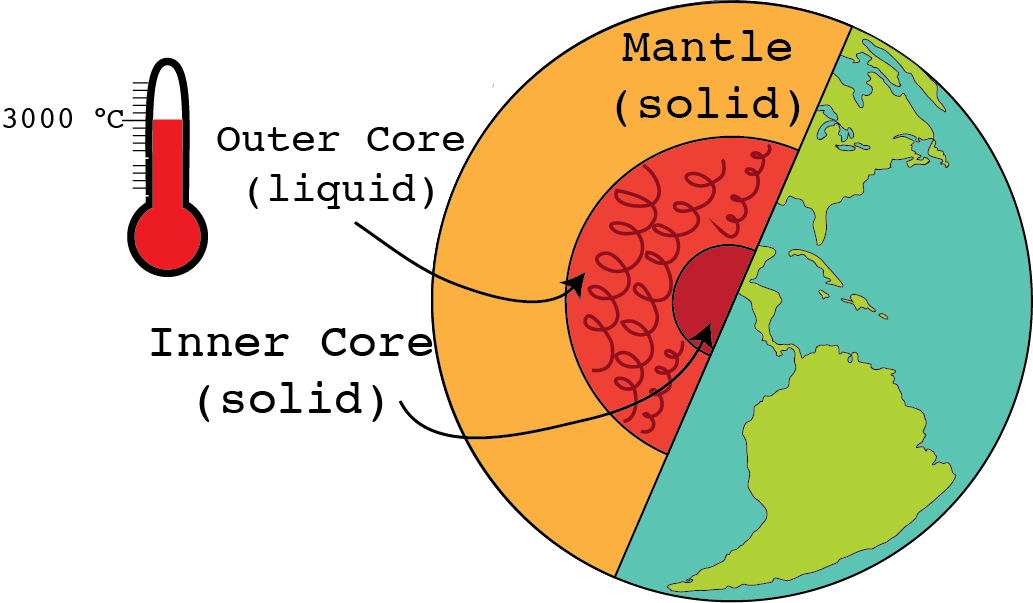 Earth’s magnetic field forms by the movement of hot liquid iron in Earth’s outer core, which is the only liquid layer inside the Earth.
Earth’s magnetic field forms by the movement of hot liquid iron in Earth’s outer core, which is the only liquid layer inside the Earth.
You can think of the Earth’s magnetic field as if there is a bar magnet inside the earth, that is roughly aligned with Earth’s rotation axis. This magnet has two poles; a north and a south pole, and this ‘dipole’ is responsible for ~95% of Earth’s magnetic field. The remaining 5% of the field arises from more complex magnetic behaviour. The magnetic field varies on timescales from seconds to hundreds of millions of years, and this causes the location of the magnetic poles to move around, and sometimes the north and south pole switch positions completely. When they flip, our compasses no longer point to the north, but to the south instead.
Throughout human history, Earth’s magnetic field has been strong and stable, but we are starting to understand that this was not always the case. But while today we use satellites to continuously measure the magnetic field, how do we study something that we cannot even see or touch, millions of years in the past?
Rocks can capture the magnetic field when they are formed. Magnetic minerals inside rocks align themselves to the magnetic field, and these ‘magnetisations’ are locked in. This way, rocks can remember Earth’s magnetic field at the time that the rocks formed. So scientists can study rocks of millions or even billions of years old to find out about Earth’s magnetic field at that time. The study of Earth’s magnetic field in the past is called ‘paleomagnetism’.
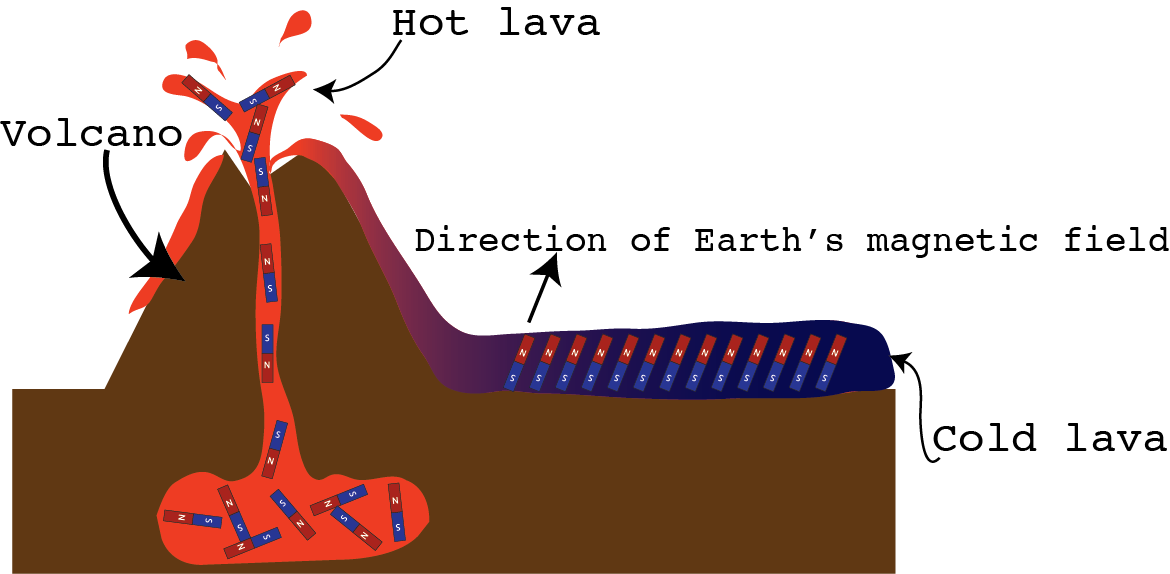 Magnetic minerals inside hot lava align themselves with Earth’s magnetic field. When the lava cools down, this magnetic direction is locked in. Scientists can use this to reconstruct Earth’s magnetic field millions of years after the rock is formed.
Magnetic minerals inside hot lava align themselves with Earth’s magnetic field. When the lava cools down, this magnetic direction is locked in. Scientists can use this to reconstruct Earth’s magnetic field millions of years after the rock is formed.
Scientists have collected paleomagnetic data for more than 60 years, and our understanding of the long-term behaviour of Earth’s magnetic field has grown tremendously. We now have a pretty good understanding of the magnetic field for most of the last 500 million years, but one big gap has been plaguing scientists for decades: the Devonian, from 420-360 million years ago.
 Geological time scale with the polarity of Earth’s magnetic field. We can see that there are many more reversals than mass extinctions throughout Earth’s history. A time interval with a single polarity is called a ‘chron’, ‘superchrons’ have the same polarity for millions of years on end. The last time Earth’s magnetic poles reversed was 780 thousand years ago.
Geological time scale with the polarity of Earth’s magnetic field. We can see that there are many more reversals than mass extinctions throughout Earth’s history. A time interval with a single polarity is called a ‘chron’, ‘superchrons’ have the same polarity for millions of years on end. The last time Earth’s magnetic poles reversed was 780 thousand years ago.
Rocks from the Devonian have a poor memory of the magnetic field at that time and show that they remember magnetic fields from a younger time period instead. New research of many paleomagnetic data from the Devonian shows that the magnetic field at that time was so weak and variable, that it prevented rocks from becoming properly magnetised. Instead, Devonian rocks locked in directions of the Kiaman reversed superchron, when the field was much stronger. We now think that the protection of Earth’s magnetic field in the Devonian could have been so weak, that it poorly protected life on Earth, and this may have affected plants and animals. Luckily Devonian fish did not rely on satellites for their navigation…
Our research shows that when we look back in time, Earth’s magnetic field behaved very differently from today. This new research can help us understand how and when Earth’s inner and outer cores have formed, which in turn can be used to improve computer models of Earth’s magnetic field.
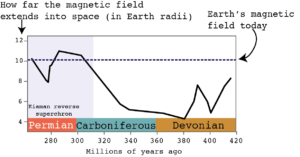
The stronger Earth’s magnetic field is, the further it extends into space. Today, Earth’s magnetic field is strong, but in the Devonian it was extremely weak.
References:
Hansteen, Christopher. Untersuchungen über den Magnetismus der Erde. Vol. 1. Lehmann und Gröndahl, 1819. http://runeberg.org/magnet/
A. van der Boon, A. J. Biggin, D. Thallner, M. W. Hounslow, R. Bono, K. Wójcik, M. Paszkowski, P. Königshof, T. de Backer, P. Kabanov, R. VandenBerg, A Persistent Non-uniformitarian Paleomagnetic Field in the Devonian? Earth Science Reviews, in press, https://www.sciencedirect.com/science/article/pii/S001282522200157X
van der Boon, A., 2019. Ten things you might not know about the Earth’s magnetic field. https://doi.org/10.13140/RG.2.2.17119.82089

